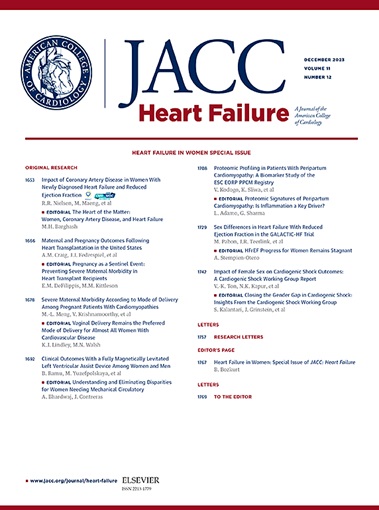Center- vs Home-Based Cardiac Rehabilitation in Patients With Heart Failure
IF 10.3
1区 医学
Q1 CARDIAC & CARDIOVASCULAR SYSTEMS
引用次数: 0
Abstract
Background
Despite being an evidence-based intervention, the implementation of cardiac rehabilitation (CR) is often unsatisfactory, especially among patients with heart failure (HF). Home-based CR can serve as an alternative to improve accessibility for patients unable to participate in center-based programs.
Objectives
The study sought to compare the clinical impact of center- vs home-based CR in HF patients.
Methods
Single-center, parallel group, noninferiority trial, enrolling HF patients irrespective of ejection fraction. Patients were randomly allocated in a 1:1 ratio, then adjusted to a 1 center/2 home ratio during the COVID-19 pandemic, then adjusted to 12 weeks of a standard center-based (24 supervised exercise sessions) or home-based CR (4 supervised sessions plus 20 sessions at home, asynchronously monitored by telephone using wearable smartwatch data) program. The primary outcome was change in peak oxygen uptake (Vo2peak) at 12 weeks.
Results
Of the 120 patients (age 62 ± 11 years, 66% men, mean left ventricular ejection fraction 36 ± 11%) who were randomized to center-based (n = 45) or home-based (n = 75) CR, 95 (79%) had complete Vo2peak data at the 12-week assessment: 34 (76%) in the center-based group and 61 (81%) in the home-based group. No significant between-group differences were found in Vo2peak change from baseline to week 12 (0.8 mL/kg/min [95% CI: 1.8 to −0.16 mL/kg/min]; P = 0.10). Additionally, no between-group differences were found for changes in the prespecified secondary outcomes: 6-minute walking distance, Minnesota Living with Heart Failure Questionnaire scores, disease-related biomarkers, and physical fitness. Exercise adherence to the CR program was similar between groups (home-based 84% vs center-based 81%).
Conclusions
In a contemporary well-treated HF population, home-based CR was noninferior to the center-based program, supporting the home-based approach as an effective and feasible alternative to the traditional center-based programs. (EXercise InTervention in Heart Failure [EXIT-HF]; NCT04334603).
心衰患者中心与家庭心脏康复:EXIT-HF随机对照试验
背景:尽管是一种循证干预,但心脏康复(CR)的实施往往不令人满意,特别是在心力衰竭(HF)患者中。以家庭为基础的CR可以作为一种替代方案,改善无法参加中心项目的患者的可及性。目的:本研究旨在比较中心与家庭CR对心衰患者的临床影响。方法:单中心,平行组,非劣效性试验,纳入不考虑射血分数的HF患者。患者按1:1的比例随机分配,然后在COVID-19大流行期间调整为1中心/2家庭的比例,然后调整为12周的标准中心训练(24次有监督的锻炼)或家庭训练(4次有监督的锻炼加上20次在家锻炼,通过电话使用可穿戴智能手表数据进行异步监测)。主要终点是12周时峰值摄氧量(Vo2peak)的变化。结果:120例患者(年龄62±11岁,男性66%,平均左室射血分数36±11%)随机分为中心治疗组(n = 45)和家庭治疗组(n = 75),其中95例(79%)在12周评估时具有完整的Vo2peak数据:中心治疗组34例(76%),家庭治疗组61例(81%)。从基线到第12周,组间vo2峰值变化无显著差异(0.8 mL/kg/min [95% CI: 1.8至-0.16 mL/kg/min];P = 0.10)。此外,在预先指定的次要结果:6分钟步行距离、明尼苏达州心力衰竭患者问卷评分、疾病相关生物标志物和身体健康方面,没有发现组间差异。两组间CR计划的运动依从性相似(家庭基础84% vs中心基础81%)。结论:在当代治疗良好的心衰人群中,以家庭为基础的CR不低于以中心为基础的方案,支持以家庭为基础的方法作为传统的以中心为基础的方案的有效和可行的替代方案。心力衰竭的运动干预[EXIT-HF];NCT04334603)。
本文章由计算机程序翻译,如有差异,请以英文原文为准。
求助全文
约1分钟内获得全文
求助全文
来源期刊

JACC. Heart failure
CARDIAC & CARDIOVASCULAR SYSTEMS-
CiteScore
21.20
自引率
2.30%
发文量
164
期刊介绍:
JACC: Heart Failure publishes crucial findings on the pathophysiology, diagnosis, treatment, and care of heart failure patients. The goal is to enhance understanding through timely scientific communication on disease, clinical trials, outcomes, and therapeutic advances. The Journal fosters interdisciplinary connections with neuroscience, pulmonary medicine, nephrology, electrophysiology, and surgery related to heart failure. It also covers articles on pharmacogenetics, biomarkers, and metabolomics.
 求助内容:
求助内容: 应助结果提醒方式:
应助结果提醒方式:


